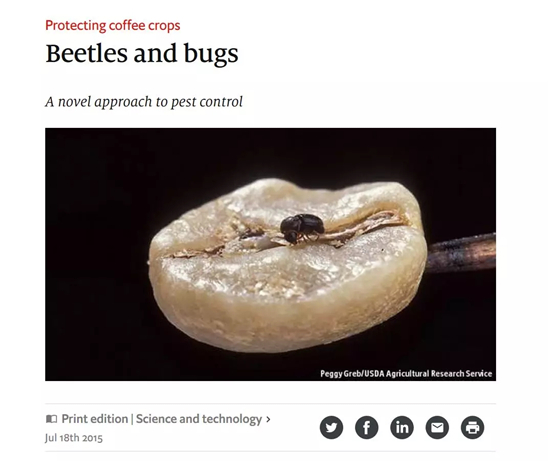2018年12月亚太地区SAT考试阅读部分考情速递!(第三篇)
2018年12月份的SAT考试已经结束了,各位小伙伴考的怎么样呢?上海SAT培训小编为大家整理出了阅读部分和写作部分的考题,考完的小伙伴可根据原题进行总结,还参加12月份考试的可以了解一下本次的出题方向和特点。前两篇小编已经发过了,今天接着分享第三篇
相关阅读:
2018年12月亚太地区SAT考试阅读部分考情速递!(第二篇)
第三篇
节选自 protecting coffee crops Beetles and Bugs

考题文章节选:
THE coffee-berry borer is a pesky beetle. It is thought to destroy $500m-worth of unpicked coffee beans a year, thus diminishing the incomes of some 20m farmers. The borer spends most of its life as a larva, buried inside a coffee berry, feeding on the beans within. To do so, it has to defy the toxic effects of caffeine. This is a substance which, though pleasing to people, is fatal to insects—except, for reasons hitherto unknown, to the coffee-berry borer. But those reasons are unknown no longer. A team of researchers led by Eoin Brodie of Lawrence Berkeley National Laboratory and Fernando Vega of the United States Department of Agriculture had a suspicion the answer lay not with the beetle itself, but with the bacteria in its gut. As they outline in Nature Communications, that suspicion has proved correct.
咖啡浆果蛀虫是一种讨厌的甲虫。据认为,它每年会毁掉价值5亿美元的未切碎的咖啡豆,从而减少约2000万农民的收入。蛀蛀虫的大部分生命是作为幼虫度过的,被埋在咖啡浆果里,以里面的豆子为食。要做到这一点,它必须对抗咖啡因的毒性作用。这种物质虽然令人愉悦,但对昆虫却是致命的——除了,由于迄今为止未知的原因,对咖啡浆果蛀虫来说。但这些原因不再是未知的。由劳伦斯伯克利国家实验室的Eoin Brodie和美国农业部的Fernando Vega领导的研究小组怀疑答案不在于甲虫本身,而在于其肠道中的细菌。正如他们在自然通信中所说的那样,这种怀疑被证明是正确的。
The team’s hypothesis was that the borer’s gut bacteria are shielding it by eating any caffeine it has ingested before the poison can be absorbed through the insect’s gut wall. Experiments on a laboratory-reared strain of the borer suggested this hypothesis was probably true. Initially, the larvae’s droppings were caffeine-free. When the lab-reared insects were dosed with antibiotics, this changed. Caffeine started appearing in their droppings, and the animals themselves began, as it were, dropping off the perch. Over the course of an experiment lasting 44 days after their guts had been sterilised (a period that let the insects complete an entire life cycle of egg, larva, pupa and adult), the population of the experimental colonies fell by 95%—and even those larvae that did not die had trouble pupating. Clearly, immunity to caffeine was being conferred by bacteria. The question was, which ones?
研究小组的假设是蛀蛀的肠道细菌在通过昆虫的肠壁吸收毒物之前通过吃掉它摄取的任何咖啡因来屏蔽它。在实验室饲养的蛀蛀菌株上的实验表明这个假设可能是正确的。最初,幼虫的粪便是无咖啡因的。当实验室饲养的昆虫服用抗生素时,这种情况发生了变化。咖啡因开始出现在它们的粪便中,动物们自己也开始从栖木上掉下来。经过长达44天的实验,这些昆虫的肠道被消毒(这段时间让昆虫完成卵、幼虫、蛹和成虫的整个生命周期),实验群体的数量减少了95%,甚至那些没有死亡的幼虫也难以化蛹。显然,对咖啡因的免疫力是细菌所赋予的。问题是,哪一个?
To answer that, Dr Brodie and Dr Vega turned to wild beetles. They collected samples from seven coffee-growing countries and combed through the insects’ gut floras, looking for features in common. By constructing what was, in effect, a Venn diagram of microbes from these populations, and also those from their lab-bred strain, they were able to focus on the bacterial species found in all of them.
为了回答这个问题,班纳伊博士和维嘉博士求助于野生甲虫。他们从七个咖啡种植国采集样本,梳理昆虫肠道菌群,寻找共同特征。实际上,通过构建来自这些种群的微生物,以及来自它们的实验室繁殖菌株的微生物的Venn图,它们能够将重点放在所有种群中发现的细菌物种上。
They tried growing each of these on a medium whose only source of carbon and nitrogen for metabolism was caffeine. Some of the bugs were able to survive on this diet, others were not. Of the survivors, the most abundant in beetle guts was Pseudomonas fulva. This species, a genetic analysis showed, is blessed with an enzyme called caffeine demethylase, which converts caffeine into something that can be dealt with by normal metabolic enzymes.
他们试着在培养基上培养它们,培养基中碳和氮的新陈代谢的来源是咖啡因。有些虫子能够在这种饮食中存活,而其他的则不能存活。在幸存者中,甲虫最丰富的是Pseudomonas fulva。遗传分析表明,这种植物有一种叫做咖啡因脱甲基酶的酶,它能将咖啡因转化成能被正常代谢酶处理的物质。
Kill P. fulva, then, and you would probably kill the borer. But that is easier said than done. Even if spraying coffee plantations with antibiotics were feasible and would do the job (by no means certain, for the larvae would have to ingest sufficient antibiotic for the purpose), it would be undesirable. The profligate use of antibiotics encourages resistance, thus making them less effective for saving human lives.
杀了P.ulva,你可能会杀死蛀虫。但说起来容易做起来难。即使用抗生素喷洒咖啡种植园是可行的,并且能够完成任务(绝不能确定,因为幼虫必须为此摄取足够的抗生素),它也是不受欢迎的。滥用抗生素鼓励产生耐药性,从而使它们对于挽救人类生命没有那么有效。
There might, though, be another way of getting at P. fulva. This would be to craft a type of virus, known as a bacteriophage, specific to the bug—an approach already being investigated for the treatment of human illness caused by a different species of Pseudomonas.
不过,也许有另一种方法可以得到P.富尔瓦。这将是制造一种病毒,称为噬菌体,专门针对这种细菌-一种已被研究用于治疗由不同种类的假单胞菌引起的人类疾病的方法。
In practice, more than one type of phage would probably be needed, for if P. fulva were knocked out, another caffeine-consuming bacterium in the beetle’s gut might end up replacing it. But, regardless of the details, this study has introduced a novel way of thinking about pest control. Many plants use poisons to protect themselves from insects. Sometimes, such plants are crops. Being able to circumvent these natural insecticides is an important part of becoming abundant enough to constitute a pest. It is possible other agronomists who have been seeking to understand how critters do this have been looking in the wrong place—ie, at the critters themselves, rather than among the bacteria in their guts.
实际上,可能需要一种以上的噬菌体,因为如果富尔瓦链球菌被敲除,甲虫肠道中另一种消耗咖啡因的细菌可能最终取代它。但是,不管细节如何,这项研究引入了一种新的思考害虫控制的方法。许多植物使用毒药来保护自己免受昆虫侵害。有时,这种植物是庄稼。能够避开这些天然杀虫剂是变得足够丰富以构成害虫的重要部分。也许其他一直试图理解生物如何做到这一点的农学家们已经把目光投向了错误的地方——即生物本身,而不是它们肠道中的细菌。
上海SAT培训哪家好?新航道sat培训,小班教学,团队一对一指导,助教全程跟踪辅导,直达高分不在是梦。










